
Dogwood Winter 2015
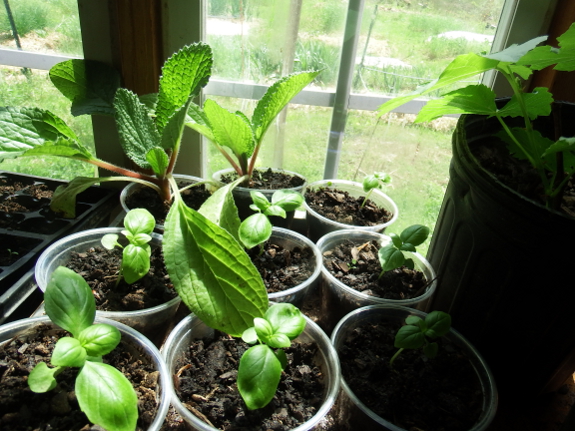
We're currently in the
middle of Dogwood Winter 2015, an annual event that seems to determine
whether or not we get fruit from our trees each year. In 2014, the
Dogwood Low was 25, which meant no fruit. The year before, the Dogwood
Low was 29, which meant good fruit production. This year, we dropped
down to 27 --- only time will tell which way the fruit teeter-totter
tipped.
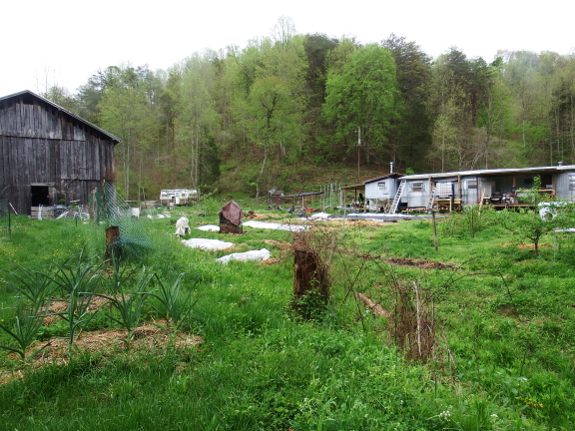
This is what our farm looks like
during Dogwood Winter. The white splotches are row-cover fabric laid
over potentially tender broccoli and blooming strawberries. The figs are
also still covered --- maybe I'll take off their tarps once the
beautiful, sunny weather returns.
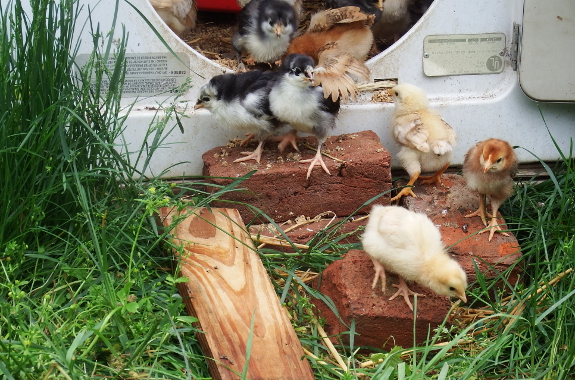
Unlike the garden, our chicks are largely unfazed by the cold weather. Starting when they're a week old, I let the baby birds run out the door of their brooder
if the grass is dry, if no rain is in the forecast, and if I'm going to
be nearby. Their first day out, the chicks always wander out of sight
of the doorway and then get terrified that they're alone in the wide
world...meaning that I have to herd them back home. But by day three,
the baby chickens are largely self sufficient, picking their way through
the tall (to them) grasses in search of bugs.
Yes, the chicks do go back inside by themselves at night (and then I
shut the door for predator protection). Yes, we do keep the baby chicks
within ten feet of our back door, also for predator protection. No, I
wouldn't recommend using even this ultra-safe pasturing technique with
one-week-old Cornish Cross.
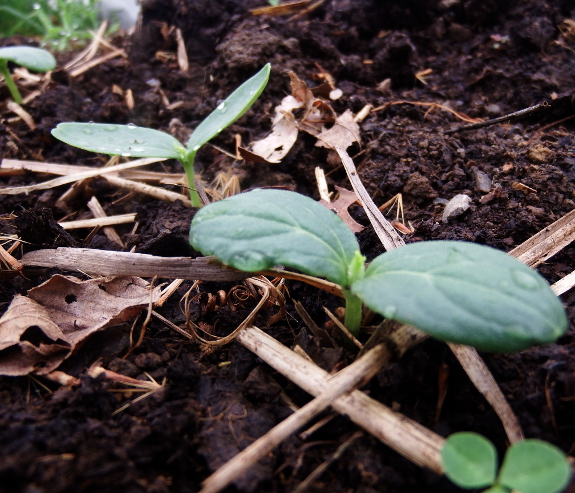
In other news, the crazy
warm spell that preceded Dogwood Winter tempted germination of the
cucumbers and watermelons I plant under quick hoops at this time of year
to jumpstart the season. I was relieved to see that 27 degrees outside
was warm enough under the quick hoops not to nip the cucurbits' tender
leaves. So maybe we'll get early cucumbers again this year --- always a
treat when the spring harvests start to expand out into summer
offerings.
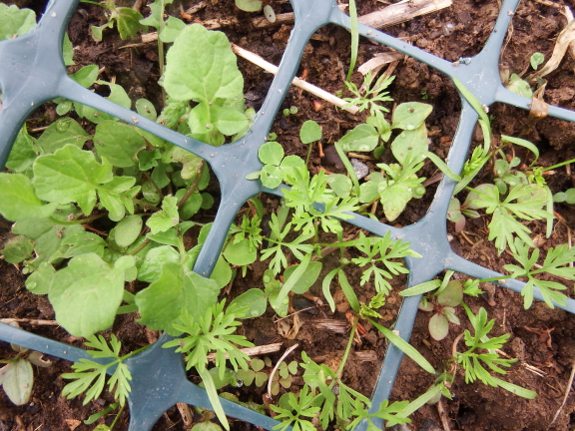
Elsewhere in the garden, we're raking in the lettuce and asparagus
(best year ever for the latter!), and are watching our other spring
crops slowly grow and mature. Our carrots always require a meticulous
hand-weed at this time of year since they're so slow to germinate,
meaning that weeds have time to slip under their emerging canopy. That
task is on the agenda for the week to come. I'll be thinning the
seedlings too...except in the bed where I forgot to lay down my Huckleberry deterrent, with the result that the carrot seedlings were naturally thinned. Thanks, you ornery old cat....
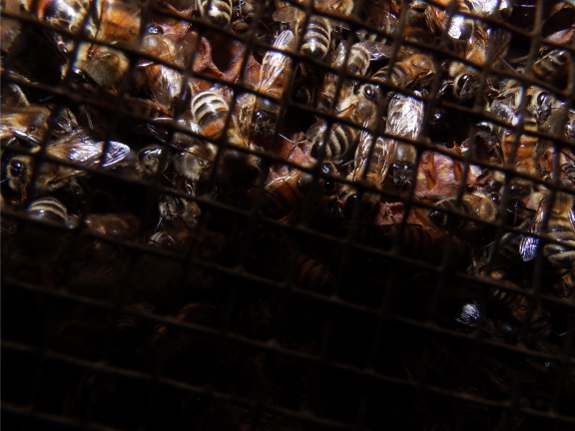
Next door, a photo up under the hive
shows that a week or two of sugar water was enough to get the colony
growing like crazy. With the bees working down in the bottom box, it's
time to nadir on a new living space.
In other bee news, we
were supposed to be getting our bees this week, but apparently rain
slowed down the works so they'll be yet another week late. Here's hoping
this very tardy start on the new colony doesn't prevent the bees from
storing up enough honey to make it through the winter. I guess I'll have
to commit to more feeding than usual....
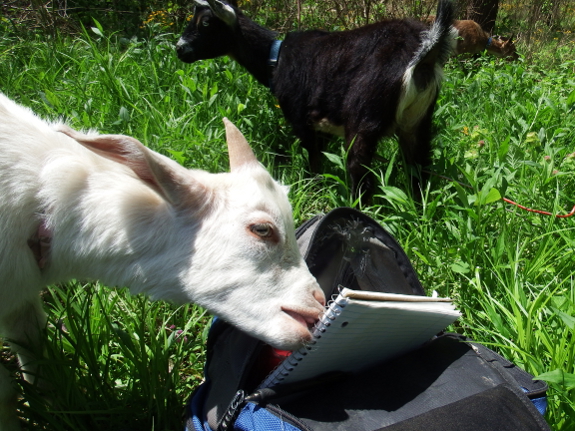
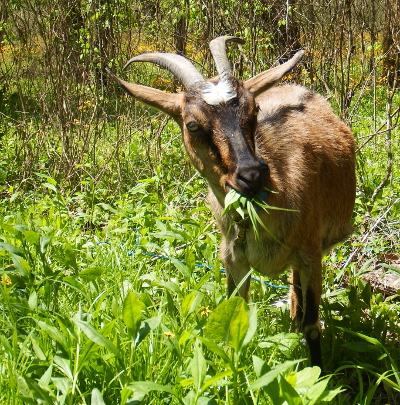 Of
course, I couldn't wrap up this here-and-there post without a shot or
two of the goats, out enjoying a beautiful sunny day before the cold
weather hit. It's amazing how different Abigail looks now that she's
getting nearly as much grass as she can eat. Her hair seems to be more
shiny and her weight --- which was slowly drifting downward ever since
she popped out her kid --- has stabilized. I guess eating hay and eating
grass are as different as subsisting on canned soups versus gorging on
spring asparagus. The former will keep you alive, but the latter makes your whole outlook brighter....
Of
course, I couldn't wrap up this here-and-there post without a shot or
two of the goats, out enjoying a beautiful sunny day before the cold
weather hit. It's amazing how different Abigail looks now that she's
getting nearly as much grass as she can eat. Her hair seems to be more
shiny and her weight --- which was slowly drifting downward ever since
she popped out her kid --- has stabilized. I guess eating hay and eating
grass are as different as subsisting on canned soups versus gorging on
spring asparagus. The former will keep you alive, but the latter makes your whole outlook brighter....
Want more in-depth information? Browse through our books.
Or explore more posts by date or by subject.
About us: Anna Hess and Mark Hamilton spent over a decade living self-sufficiently in the mountains of Virginia before moving north to start over from scratch in the foothills of Ohio. They've experimented with permaculture, no-till gardening, trailersteading, home-based microbusinesses and much more, writing about their adventures in both blogs and books.
Want to be notified when new comments are posted on this page? Click on the RSS button after you add a comment to subscribe to the comment feed, or simply check the box beside "email replies to me" while writing your comment.
- Remove comment
